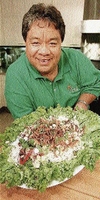Cooking Hawaiian style
Published: Saturday | August 8, 2009

Hawaiian chef Sam Choy, author of 'Sam Choy's Island Flavors', shows off one of his creations, Asian macadamia chicken salad with fried noodles. - MCT Photos
Hawaiian cooking is influenced by the culture and culinary traditions of immigrants from Asia, Polynesia, Europe and mainland America. Hawaii, now a major crossroad of cultures, boasts an exciting and eclectic cuisine that is gaining world-class recognition, according to chef Choy, a household name in Hawaii and who brings a dramatic flair to Hawaiian home-cooking. (Sam Choy's Island Flavours)
Seafood catch
Hawaii has a unique cuisine because of the diverse background of its people. When the first set of Polynesians arrived in the islands, they could not find much to eat. Luckily, the Polynesians took with them pigs, chickens, taro and sweet potatoes and they were able to get a good catch of seafood, which became a menu staple.
The missionaries from New England brought to the islands cows, sheep and goats and a variety of new plants which immensely changed the diet of Hawaiians. Labourers brought in from China, Japan, Korea, Philippines and Puerto Rico to work on mammoth sugar plantations took new cooking traditions with them.
The mix of foods from different cultures led to what became known as 'Local Food' popularised by lunch-wagon cooks and small stores and restaurant. The range of restaurants includes American, Chinese, Korean and Local Food.
Obama at home
When United States President Barack Obama goes to his hometown in Hawaii, apart from recharging batteries, who knows what he will eat. He may consider having the plate lunch, a Hawaiian staple made up of two scoops of rice, one scoop of macaroni and meat or fish entrée covered with gravy and some shredded cabbage to soak up some of the oil. President Obama may order a 'Zip Min', a variation of saimon, the Japanese noodle soup that evolved to everything-but-the-kitchen-sink concoction, SFGate.com reveals.
Jamaicans can identify with President Obama's desire to satisfy his craving by indulging in shaved ice, a local version of snow cone with a rainbow of tropical flavours and toppings. He may also eat cones with ice cream with his daughters.
Fish in banana leaves
Fish from the waters around the Hawaii islands are an important component of Hawaiian meals. Interestingly, ancient chiefs used to steam mild, white fish in banana leaves. The Polynesian custom of grilling fish over a fire until crispy brown with a mere sprinkle of salt is still practised today. Fish used include grouper, snapper, tuna, marlin, jack, squid and octopus. Other seafood used on the grill includes shrimp, prawns and black crab.
One of the oldest methods of cooking in Hawaii is pit cooking or barbecue. A hole is dug in the ground, filled with fire, a large animal (large hogs, whole lamb, a side of beef) is placed in it and covered to cook. This is known as Hawaiian Luau or more accurately Kalua Pig.
Oriental flavours
A new tradition of cooking had emerged in Hawaii. It is called Hawaiian Regional Cuisine and has replaced the use of Spam in Hawaii, the largest per capita consumer of Spam. The new cuisine has new flavours from the cooking traditions of the Orient and mainland United States, combined with local products. To cook Hawaiian foods well means understanding the culinary terms of the cuisine of the islands.
Heather Little-White, PhD, is a nutrition and lifestyle consultant in Kingston. Send comments to editor@gleanerjm.com or fax 922-6223.
Culinary terms
Char Sui
Rich, red spare ribs from the Chinese.
Chicken Adobo
This national dish of the Philippines,
Chicken Lu'au
Chicken cooked with taro leaves (spinach) and coconut milk.
Huli-Huli Chicken
Hawaii's version of barbecued chicken cooked in Huli-Huli Sauce (made from pure Hawaiian brown sugar with soy sauce, fresh ginger and local spices).
Kulolo
A Hawaiian pudding made of
Lu'au
Taro leaves baked with coconut cream and chicken or octopus. The word eventually came to mean a Hawaiian feast.
Mahi Mahi with Teriyaki Sauce
Marinade
White, sweet, moderately dense fish either baked or sautéed.
Pupu
A platter of hors d'oeuvres.
